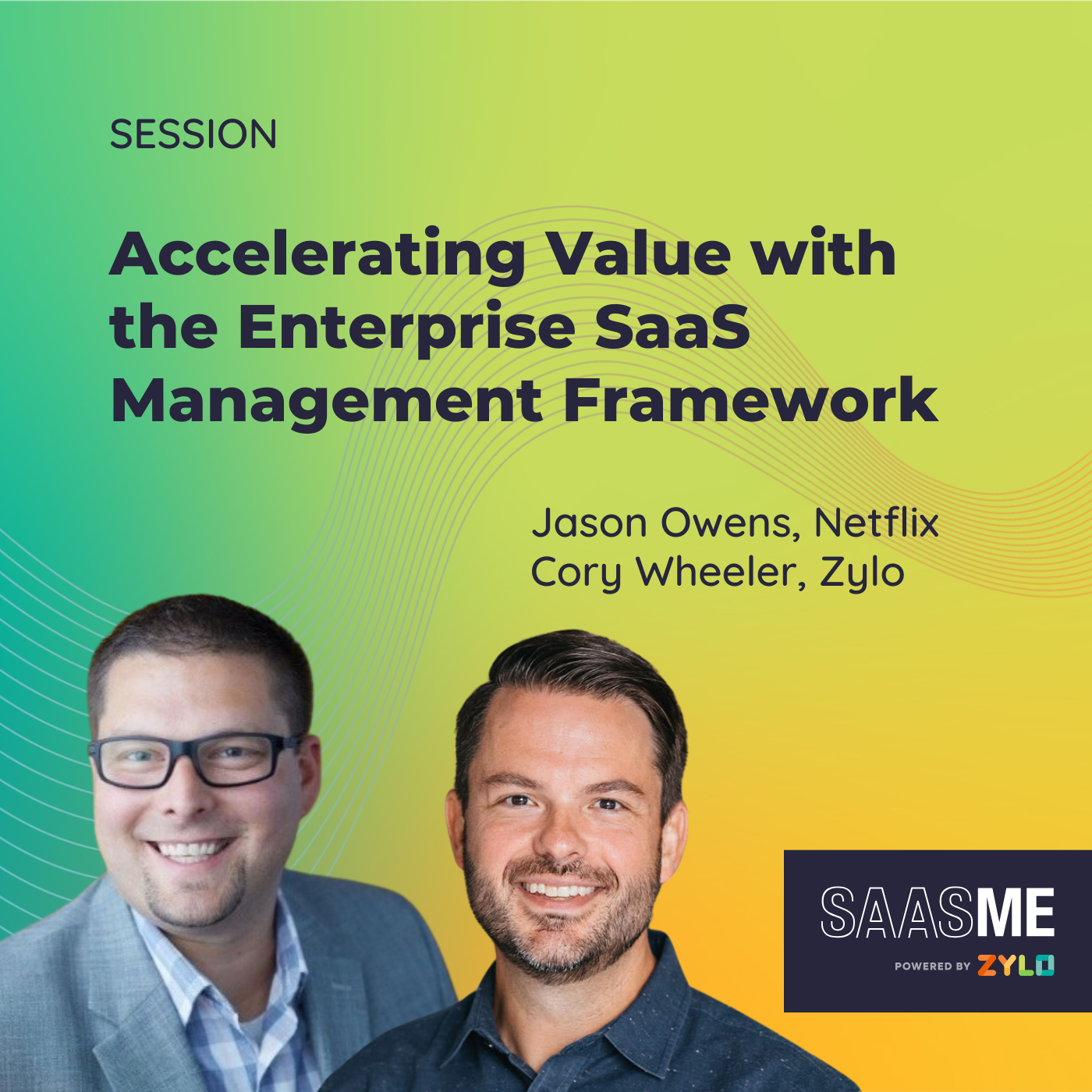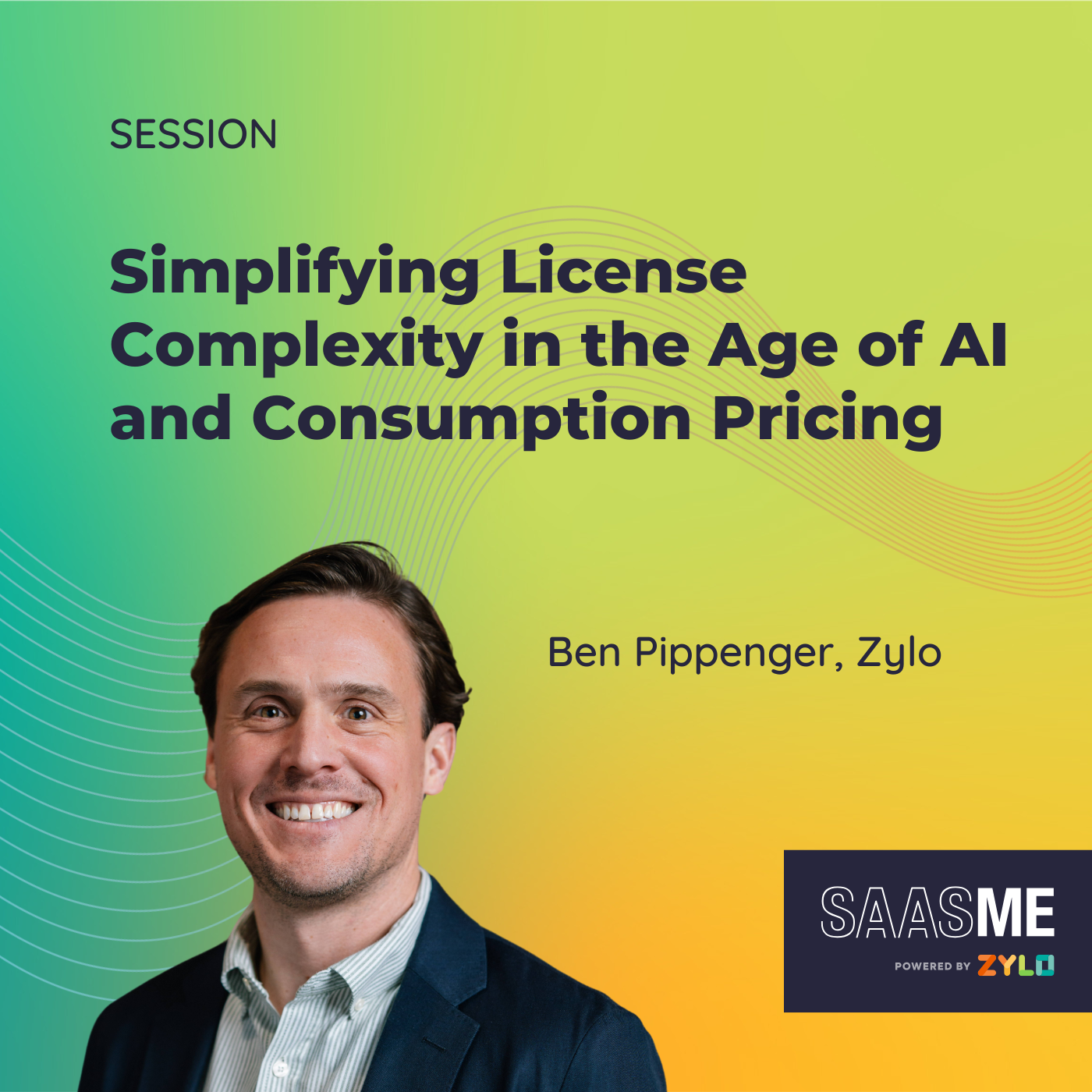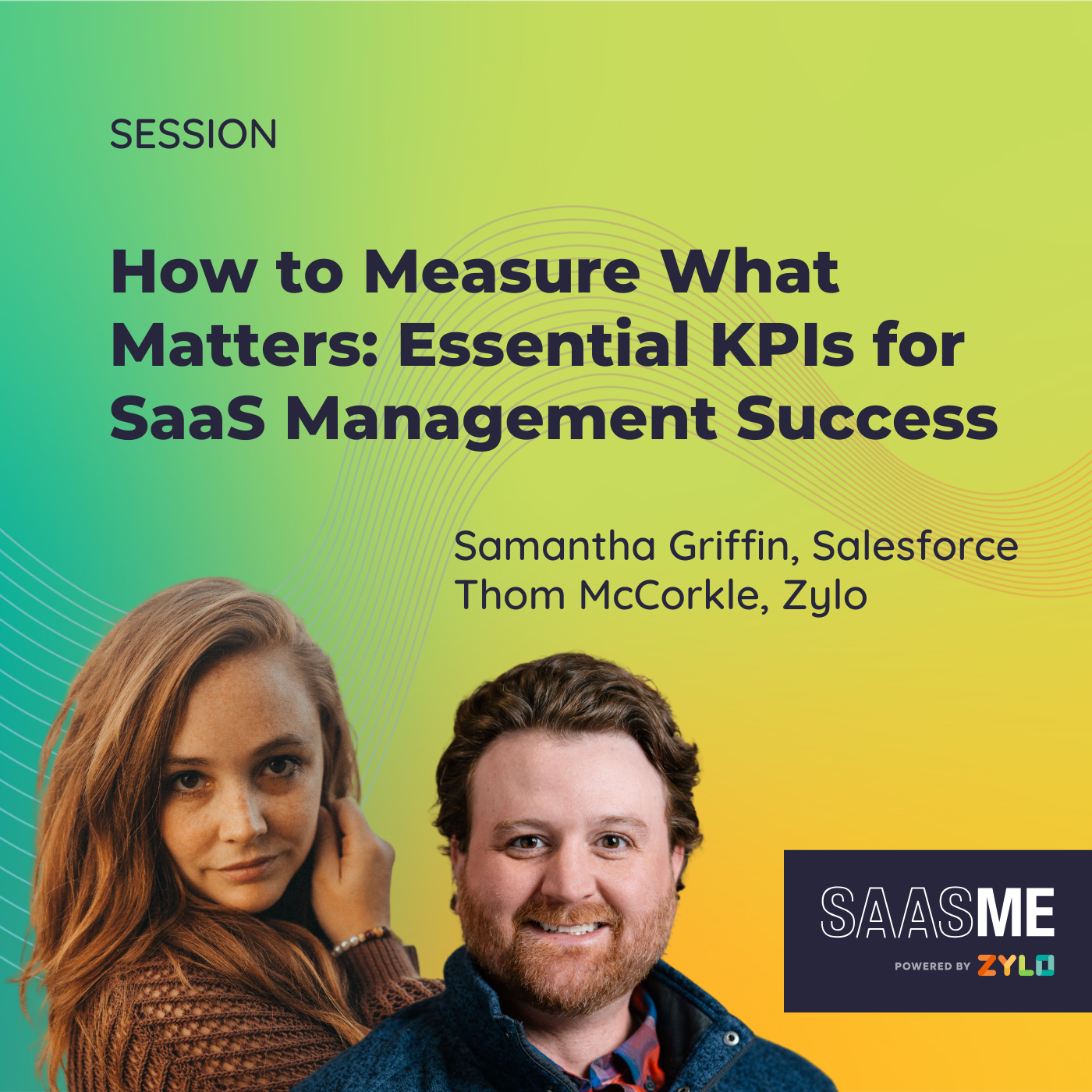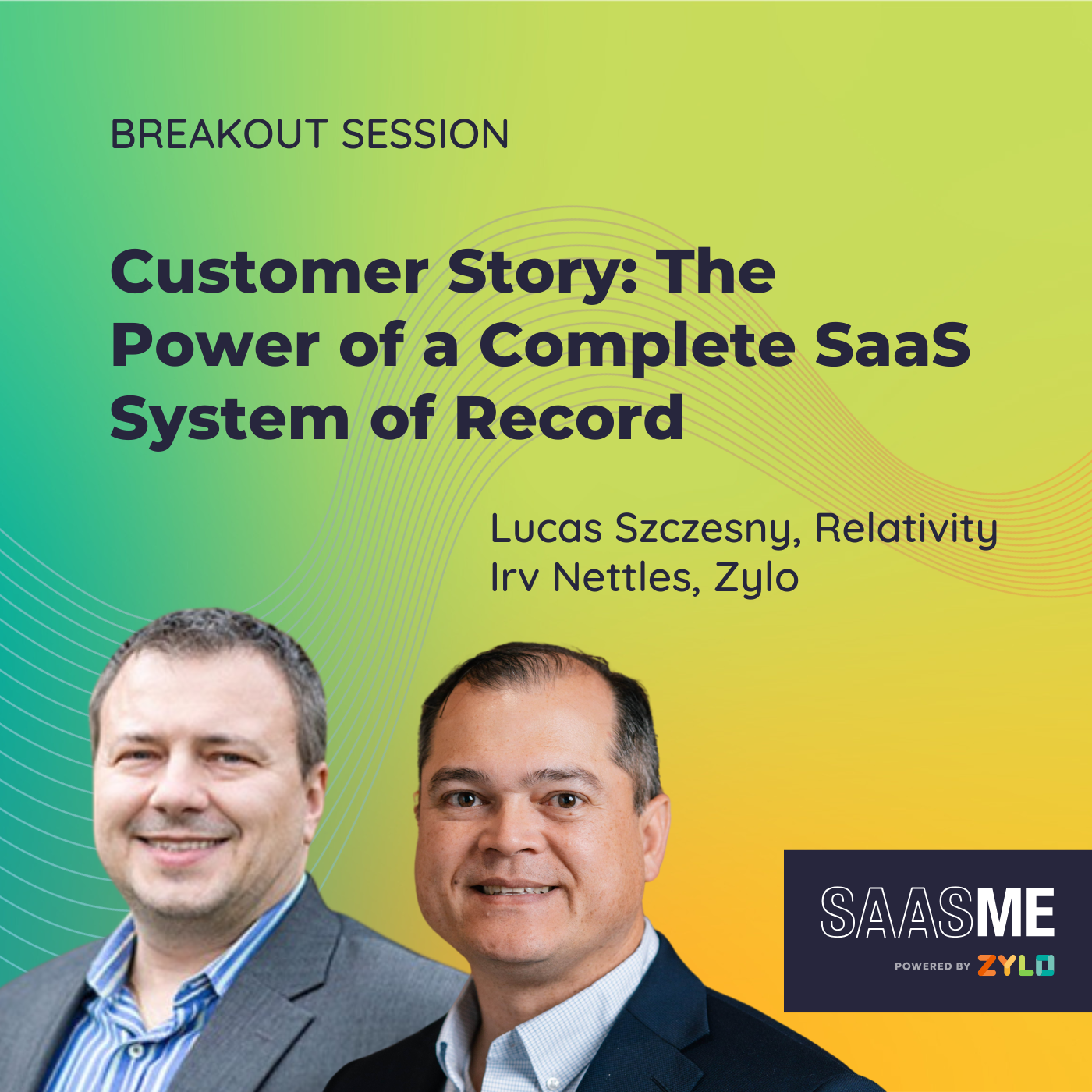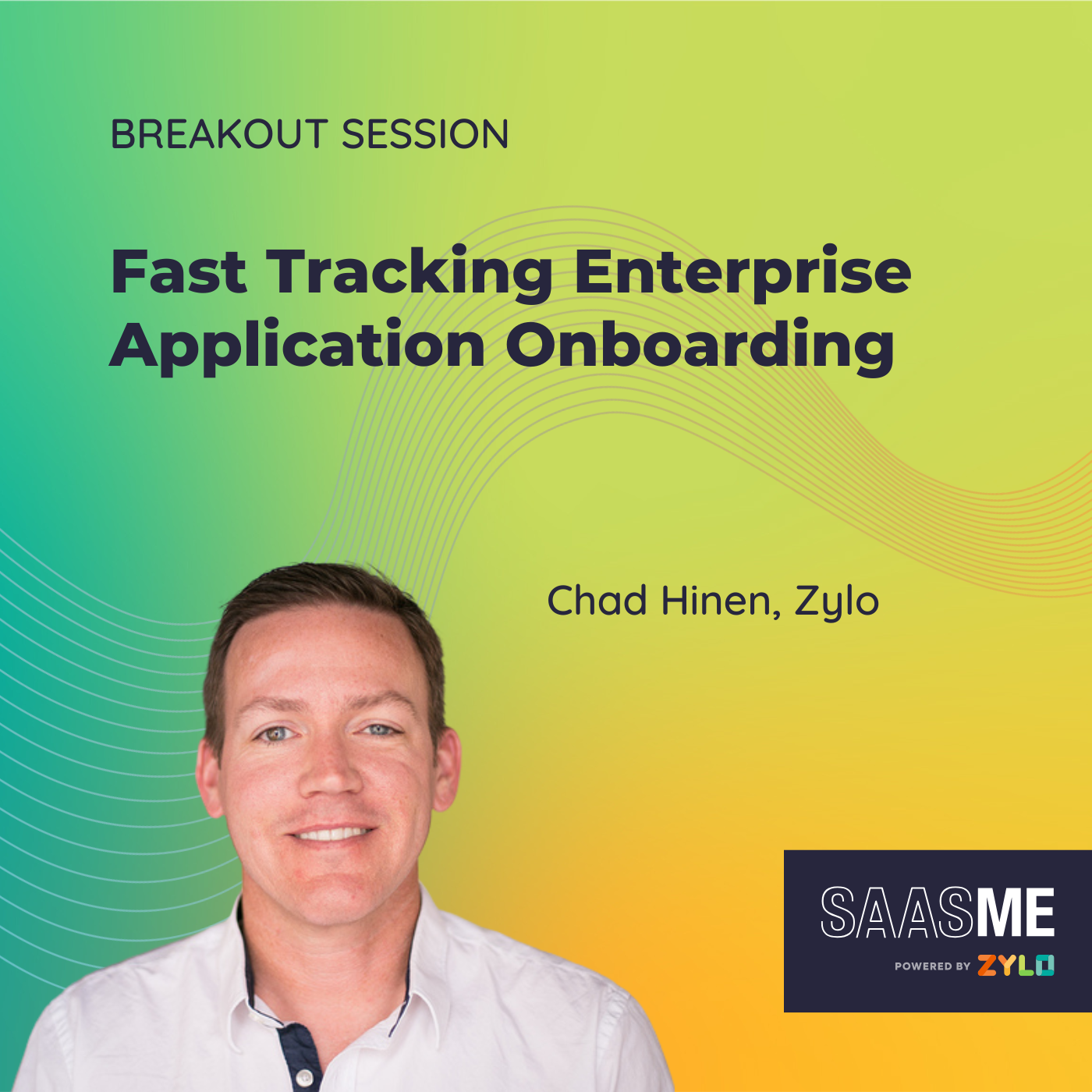SaaS Trends Shaping 2024 and Beyond
- 0.5
- 1
- 1.25
- 1.5
- 1.75
- 2
Ben Pippenger: I'm so excited to be here today with you. My name is Ben Pippenger, I am one of the co- founders here at Zylo. And also my job, my day job, I guess, is our chief strategy officer. So really excited to share with you all trends that we've captured for the last year, and also some predictions that we'll look to in 2024 and beyond.
Ben Pippenger: All right, so as we get into this, a lot of the trends that we'll be highlighting and things that we'll be showcasing are from our annual report we put out, called the SaaS Management Index. SaaS Management Index is our state of SaaS and it's based on over seven years of SaaS spend, licensing and usage data. In that seven years, it's capturing over 30 million SaaS licenses and analyzing over$ 34 billion in SaaS spend. So, it's a big data set that we're analyzing in order to create these trends and share them with you today. One thing I do want to call out about this data set though, it is anonymized and aggregated set of data from real Zylo customers, who are actively managing their SaaS. So if you're in the boat where you're not potentially managing your SaaS today, your results are going to likely look a little bit different from what we'll report on, but trends should still be some of the same stuff.
Ben Pippenger: All right. So the way I like to look at this is, first and foremost, I'd like to sort of take a step back and think not just from a Zylo perspective, but what's going on across the industry, across SaaS. And, I think the best way to do that is to look at some analysts that cover our space. So I have two to highlight today, the first one is from IDC. So IDC, they put out pretty regularly a state of the IT spend report, a market report. Back in 2022, when they put that report out, for the first time, they stated that SaaS spend surpassed on- premise spending in that year, so in 2022. Last year when they came out with that same report, they were at 60% where SaaS compromised 60% of the software spend in 2023. So we're continuing to see SaaS overtake the traditional means of software, on- premise deployments of software.
Ben Pippenger: Another analyst look at is Forrester. So Forrester came out with their predictions here this year in Forrester Predictions 2024, and they're stating that, " In 2024, late adopters will finally move towards SaaS, with only 25% staying on the sidelines."
Ben Pippenger: So, what's that mean? That means a lot of the legacy software tools that have been around for a long time providing a lot of value to a lot of companies, but have been perpetually deployed on perpetual on- premise licensing are moving to SaaS, only 25% less. So by the end of the year, we'll be at a 75, 25% split.
Ben Pippenger: One other thing to call out here is that when we started Zylo back in 2016, a lot of our first customers were cloud forward organizations. So businesses that started in the cloud, they never really even had on- premise or perpetual licensing. Everything they bought was SaaS, it was all subscription based, that's changing as well.
Ben Pippenger: So if we look at some of the recent headlines that have hit the news, we're seeing headlines from publications and firms like The Wall Street Journal, and CIO.com and TechRepublic identifying that there are challenges now that companies are facing, as they're moving towards SaaS. A lot of the challenges that I'm sure a lot of you that are with us today, are working to solve. So those challenges just aren't in the tech- forward, cloud- first organizations anymore. We're seeing this across the board, across Fortune 100 companies, across some of the largest organizations in the world are prioritizing solving that problem.
Ben Pippenger: All right. So, let's jump into the five trends I'm going to highlight today that we've captured in our SaaS management Index this year.
Ben Pippenger: Trend number one is that SaaS portfolio sizes and spend are actually going down. It's hard to believe when we think about how much chaos is created by SaaS, but we have seen a downward trend in both stack sizes and spend over the course of time. We actually saw this last year in our report as well, but I wanted to call out that we continue to see this happening. So on the left- hand side of the screen here, you're seeing the breakdown of application count based off of company sizes. So you can see from one to 500, the average number of applications they have is 162 and that continues to go up as you get into the larger enterprise, we're up over 600 applications on average. But in total, if we look across all companies, the average count of apps inside of their inventory is 269 applications. Now, that's a 17% decrease since 2021.
Ben Pippenger: Now, if we flip over to the other side here, we're looking at spend, you can see the same breakdown. If you look at by company size, all boiling up to the average spend is$ 44. 8 million a year on SaaS and that is a 25% decrease since 2021. So, what's causing that decrease? Well, first and foremost, again, we're looking at Zylo customers. These are organizations that are prioritizing solving this problem. However, you rewind the clock back to 2020, 2021, what was going on? We were all in the middle of a pandemic. We were rushed into working from home and digital transformation. And I'll tell you what, a lot of software was bought during that point in time to make sure our employees, and our end users and everyone had the right tools they needed to get their jobs done. Well, since then, there's been a rationalization. We've seen people pull back on the software they're buying. They've maybe bought too much or maybe they're not using the tools they bought back then and so, they're starting to consolidate and pull that back together. So, that's really the reason why we've seen that contraction.
Ben Pippenger: Now, that's not to say that SaaS is necessarily slowing down, I think we're just seeing that rationalization happening since the pandemic. In conjunction with that, we saw prices go down, we saw spend go down, excuse me. We also saw the cost per employee decrease as well, so this is another metric that we've tracked consistently in our SaaS Management Index. In 2022, we reported that the average spend was about$4, 600 per employee. Well, 2023, that number decreased to about 3, 900, that's about a 14% year- over- year decrease in the average cost per employee for SaaS.
Ben Pippenger: All right.
Ben Pippenger: Trend number two, IT is responsible for less software than ever before. If we rewind the clock back, if you watched my session last year, I highlighted this, rewind the clock back to the early 2000s. IT owned all the software, well now, when we look at our data, IT only owns about 17% of a company's application. So that means if a company's buying a hundred apps, IT is owning 17 of those. So you look at the breakdown there on the left- hand side, that's by spend. So from a spend perspective, they're owning 28% of the applications, the individual business units, so folks that are out buying the software are owning 69%, and shadow IT or employees are expensing about 3%. On the right- hand side is that number of applications, which is that 17% of applications that are owned by IT, 48% owned by the business units, and 35% owned by employees or shadow IT.
Ben Pippenger: The right- hand side there, we can see what the trends look like and how those numbers have shifted over time. So from IT applications, that has decreased, so it's gone down from both a spend and the app volume, 10% and 6% respectively. And then from a shadow IT perspective, I thought this is really interesting, in 2022 to 2023, the amount of spend decreased by 40% for employee- led purchasing and for shadow IT, while the app volume only went down about 5%. So, what does that tell me when I look at the data? What definitely tells me that decentralization is still happening and will continue to happen, as business units are responsible for more and more software, but it also tells me that organizations are prioritizing getting rid of shadow IT. The way they're doing that is they're looking at the highest spend applications first that employees are buying, getting those out of there, and then slowly removing the rest, but it still remains a big problem. There's still a ton of applications out there that employees are purchasing. You can see about 35% of the overall app stack. So big problems, and I'll highlight a trend as to why that remains a big issue and should be something that you all are prioritizing with your own businesses.
Ben Pippenger: All right. Trend number three, which is that reason why expensed apps carry significant security risk. So, this was something new we looked at in the report this year and it was based off of a new tech partnership that we formed with a company called, Netskope. Netskope is a leader in monitoring and managing SaaS security for organizations of, really, all sizes. They have a proprietary scoring model, they call it the Cloud Confidence Index and the Cloud Confidence Level. There's two forms of it. Where they're looking at 30 or 40 different data points and modeling that data together to come up with a risk score for software vendors, we took that risk score and we compared it to how those applications are entering into an organization's business. And what we found is that about two thirds of applications that are expensed by end users, come with either a poor or a low CCI score, CCL score, the Cloud Confidence Level score from Netskope.
Ben Pippenger: So significant number of apps being brought into the business, carry risk with them. That's on the right- hand side there in that donut. The left- hand donut there, that's the apps that are coming through your accounts payable system. So typically, going through your Infosec reviews, and privacy and legal reviews, and all that good stuff that you do as you add apps. You can see that still is a fairly high number, with about 50% of the applications coming in with a poor or low security score. So definitely something to still keep your eye on, it's a trend that hopefully, we see go down over time, that everyone is putting more governance in place as apps are coming through, and also controlling those employee expenses.
Ben Pippenger: All right. Trend number four, the modern stack is changing. When I think about last year and really, still this year, what is the number one trend that people talk about? If you didn't answer AI and I think you're probably sleeping in a cave, it's AI, AI, AI, it's everywhere. And, that also is reflected in our report this year.
Ben Pippenger: So two different things we looked at inside of the SaaS Management Index, the left- hand side are the top new expense applications that we saw enter into our customer's environment. So you can see there of the five or six or so that are listed there, about half of them are AI- based applications for OpenAI, ChatGPT, I'm going to put Grammarly in the AI bucket as well. LinkedIn and Coursera are both helping employees do better work. So we're seeing employees going out, and buying and expensing both of those types of tools. On the right- hand side are our highest growth functional areas, so we apply taxonomy to all applications as we discover them. And these are the specific functions that we saw grow, the highest across all the new apps that entered into our customer's SaaS inventories. Number one was generative AI or AI as a service. And then, number two and three were both security related, so VPN and endpoint security. So, security definitely is remaining a top priority for lots of organizations everywhere.
Ben Pippenger: All right. Our fifth and final trend I'll highlight today is that license waste is a persistent challenge. We've reported on this, I think in every SMI that we've put out. It continues to be a big challenge for organizations. It's a huge opportunity for companies to start to get their arms around, if you're not doing it yet.
Ben Pippenger: So on average, companies waste 18 million a year on unused licenses, so that's a huge astronomical figure. $ 18 million a year is being wasted on licensing. So, how do we get to that number? Well, our data that we report in the SMI, shows that about 51% of licenses are wasted or unused. So, what does that mean? That means that you're buying a license and it's just sitting on the shelf. Often, we call that shelfware. Or you're buying a license, you provision it out to an end user, that user maybe uses it once or twice, and then never logs in again. It's just an unused license that's just sitting there. So 51% of licenses are wasted, we look at that number against what our average annual license spend looks like. That 44. 9 million and that's how we get to the$ 18.4 million in wasted spend. So again, a ton of wasted spend in this area, but for sure, a really good opportunity for you to dig in and try to pull some of this back if you can, line it up to your renewals and get a plan going to claw back some of these cost savings.
Ben Pippenger: All right. So just to recap real quick, the five trends that are shaping SaaS management in 2024. Number one is the SaaS slimmed- down. We're seeing smaller portfolios and less spend happening. Number two, line of businesses own the lion's share of apps, not IT. That's continues to be a trend we see every year and I don't foresee that stopping anytime soon. Number three, employee- expensed apps pose a major security risk. The data doesn't lie here, it's definitely something you should be looking at. Shadow IT is not just a spend issue, it's also a risk issue. You should definitely be digging into that. Number four, the modern stack is evolving. We definitely saw AI be a huge component of both expense, as well as approved applications entering into the business. Security tools, employee enablement tools also were top of the list there as well. And then number five, unused licensing continues to be a big problem in drain budgets. All right, well, I didn't want to stop there, I wanted to also round things out today with a couple predictions.
Ben Pippenger: So five predictions for you entering, actually, we're not entering into 2024 anymore, I guess, we're in the midst of 2024. Number one, the CIO's role will shift away from buying to governing software. You heard of this morning in Tom's presentation from Gartner. Governance is such a big deal. CIO really needs to be focusing on making sure the business is safe, operating efficiently and owning the tools they're responsible for, but also having the governance and process in place to make sure the business is safe. Two, an evolved software asset management role is emerging or has already emerged, I would say. We're seeing more modern software asset management teams take on cloud management, take on SaaS management, shifting away from just being, looking out for risks to focusing optimization and cost savings. This role will evolve, new practices will evolve out of software asset management and really asset management in- general. So, it's a really exciting area to be watching and focused on. Number three, I do believe that organizational SaaS spend will plateau. So, we've seen that decrease over time. That is going to plateau into some level of consistent growth that we can expect year- over- year, unless some unforeseen circumstance happens, like what happened in 2020, 2021. But, I do expect that to plateau. Now, that said, out of one side of my mouth, the other side of the mouth, I am going to say, we will start to see spending increase again and AI is going to be the big driver behind this. Tools, existing platforms are introducing new AI capabilities that they are going to charge for. All y'all are probably wanting to build AI capabilities, you already are by building AI tools, that will increase costs. So I do expect spending to go up again, as companies continue to innovate and buy more tools based on AI. And then number four, SaaS management becomes business critical. So this is definitely, or number five, excuse me, SaaS management becomes business critical. We're seeing this across the board. As I said, when we started back in 2016, it was a lot of cloud- forward organizations that were prioritizing SaaS management. We're definitely seeing that shift. Lots of global enterprises, Fortune 100 companies are really thinking about how do we put a program, a practice and technology in place to solve the challenges with SaaS management.
Ben Pippenger: So, I'm going to wrap all that up and end with the fact that... I'm sorry, I have one more stat there. This is from IDC as well, third party validation here that, " 67% of businesses with a 1000 plus employees have employed a SaaS management platform," that's from a report they put out last year. So, that's a pretty just further validation that it's becoming business and mission- critical for organizations. So to wrap us all up here, when we think about the status quo, that's something that we're talking a lot about today at SaaSMe. The status quo of just operating with a spreadsheet or are operating as things currently have always run, is really not the answer anymore. You look at these trends that are happening, you look at what our customers have been able to achieve and you look at some of those predictions that are out there, with SaaS spend still continuing to grow and SaaS management becoming mission- critical, it's all the more reason and definitely time now to say no to the status quo.
Ben Pippenger: So thank you, and have a great day and enjoy SaaSMe. Appreciate it.
DESCRIPTION
Forget "business as usual." Our latest research report shows that while SaaS spend might be shrinking, shadow IT and security threats are surging. So, how can businesses adapt? How can you prepare? Dive into the data as we unpack the biggest trends, challenges, and opportunities for 2024 and beyond.
Speaker: Ben Pippenger, Co-founder & Chief Strategy Officer


